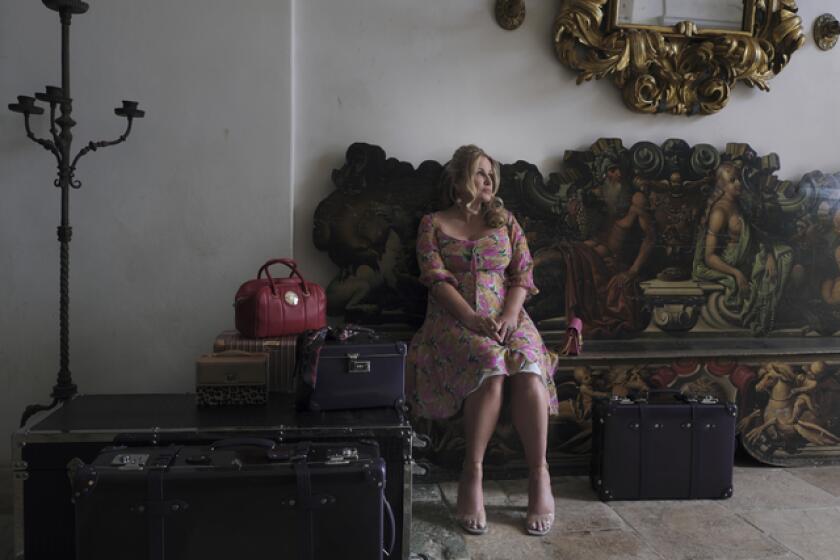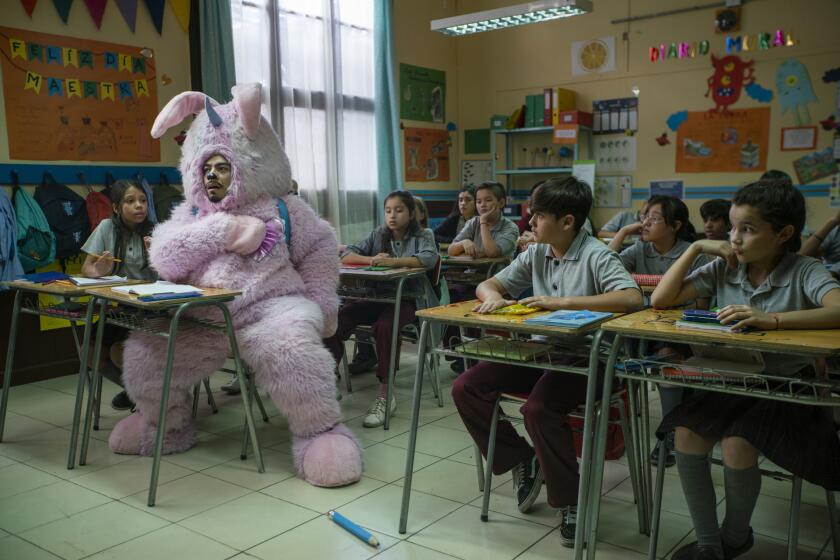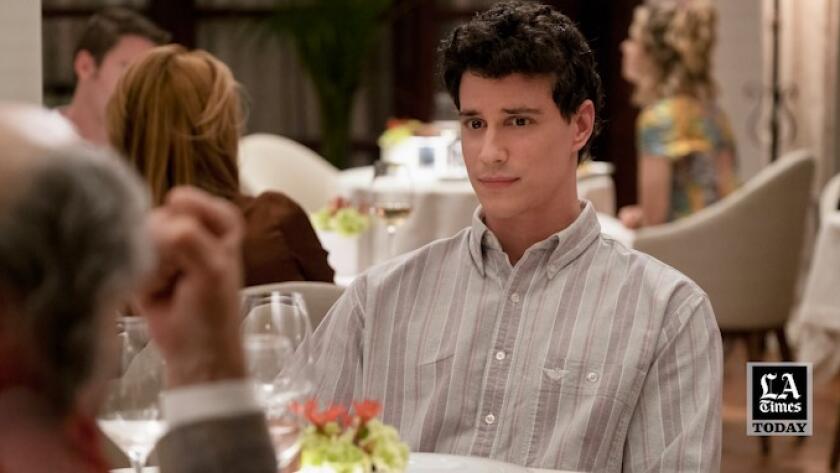How HBO’s ‘White Lotus’ captures the theater of the tourism industry
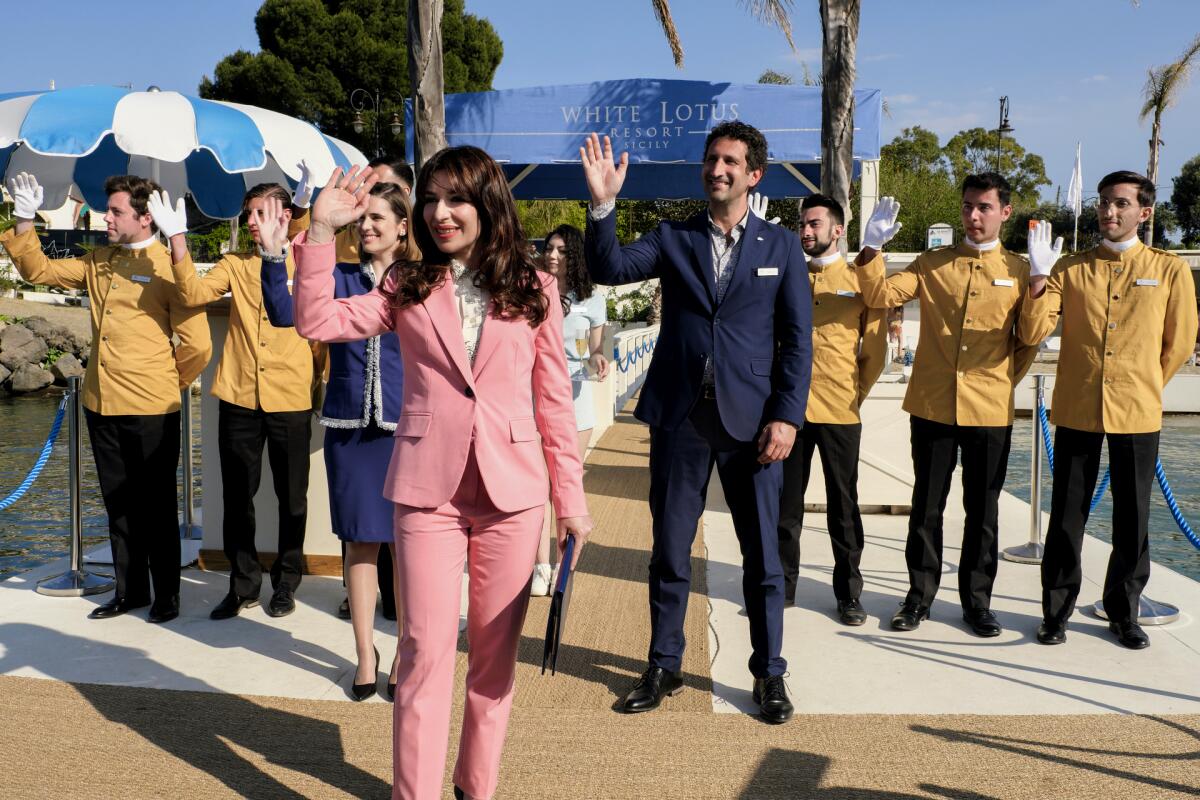
- Share via
If you were asked to sum up the travel industry in a single scene, the opening moments of HBO’s vacation dramedy “The White Lotus” would be the place to look. Staff members of a luxury resort stand on a Hawaiian dock awaiting a boatload of wealthy guests, bright smiles pasted onto their faces. “Wave like you mean it,” urges the resort’s director, Armond (the fantastic Murray Bartlett).
Minutes later, he counsels a new employee named Lani on how to behave around the hotel’s VIP clientele. “You don’t want to be too specific as a presence, as an identity — you want to be more generic,” he tells her. “We are asked to disappear behind our masks as pleasant, interchangeable helpers.”
It’s a scene repeated, to a degree, in the opening of the show’s second season, in which Valentina (Sabrina Impacciatore), the hard-driving director of the fictional resort chain’s Sicilian branch, gathers her staff to welcome a yacht-load of guests at the dock. “Greet them together,” she commands, “with the same right hand.”
Two aficionados of HBO’s hit mystery discuss every bloody detail of the Season 2 finale. Warning: major spoilers ahead!
On Sunday, the second season of “The White Lotus” came to its grotesque, gladiatorial conclusion. (You will get no spoilers from me.) The show has become a full-blown cultural phenomenon for its sumptuous locales, untimely deaths, melodramatic plot twists and haunting soundtrack, which has emerged as an earworm on TikTok. Plus, it offers the sight of unfathomably rich people being miserable on vacation. As Alex Abad-Santos has written on Vox.com, it’s the schadenfreude that keeps it so compulsively watchable.
All the buzz has generated plenty of interest in the show’s IRL locations. A representative for the Four Seasons San Domenico Palace, where this season was filmed, told the Guardian in October that the hotel was already booked through April.
I’m a latecomer to “The White Lotus.” I didn’t get to the first season until the second was about to land. But I have been intrigued by the ways it depicts tourism — especially the high-end part of the business.
At that level, travel is less about getting to know a place than in finding an outfitter willing to bend over backward to satisfy your preconceived notions of what that place might be. Is your fantasy of Italy to dress up like Italian actress Monica Vitti and putter around on a Vespa — like insecure Tanya (played to the max by Jennifer Coolidge)? Just talk to the concierge.

Before covering art and design, I worked for several years as a travel writer of little distinction, producing several guidebooks for Lonely Planet and short dispatches for outlets such as Travel + Leisure and Budget Travel. It was work for which I was terrifically ill-suited. (“Travel writing” is a misnomer. It should be called “hotel writing,” because what the industry generally wants is an amanuensis who can churn out seductive copy about high thread-count sheets and Italianate bathroom fixtures.)
What those years in the field did bestow on me, however — besides a colorful story about riding a cow truck over Costa Rica’s so-called Mountain of Death — is a front-row seat to the theater of vacation travel. And what “The White Lotus” gets right is that tourism is theater, the ultimate immersive experience in which everyone and everything has a role to play.
“The White Lotus” ably mocks the wealthy patrons of a tropical resort. Its knives would have been even sharper if it had spent more time on the staff.
Functioning as stage is the locale — which the travel industry set-designs into a hyper-quaint version of itself for the purpose of tourist appeal. Hawaii is smiling hula dancers and outrigger canoes. Italy is a paradise of Roman ruins, picturesque hillsides and Aperol spritzes. Luxury resorts, with their enviable real estate and tasteful symphonies of muted tones, offer a safe space of predictability from which to dip a toe into the local. Whale watching is at noon, the sunset cruise at 6.
Cultural critic Lucy Lippard describes the phenomenon in her 1999 book, “On the Beaten Track: Tourism, Art and Place,” which explores how popular locales are represented. “Across the United States, towns devastated by capital flight, technological shifts, or union-busting make spectacles of themselves desperately framing and reinventing their histories to make the picture appealing to those who might buy a hamburger, T-shirt, suntan lotion, Indian jewelry, a plastic sea gull, a shell ashtray, or a boat ride.”
If you’re one of the extravagant guests of “The White Lotus,” instead of an ashtray you might arrange to spend the night at the 16th century neoclassical palazzo where Wagner composed part of “Parsifal.”

This hyperbolic manufacturing of place can manifest in absurd ways. I once covered an Orlando hotel whose design featured miniature versions of famous Florida sights on the grounds, including a fake Everglades swamp stocked with real alligators.
Hyperbole, however, can overwrite reality. In Costa Rica, where I’ve done a lot of reporting, the set on offer is tropical nature and pura vida vibes. The country is regularly billed as one of the happiest places on Earth, based on studies that purport to rank national contentedness. This is touted all over travel brochures, adventure company websites and a massive banner I once saw hanging over the courtyard of a San Jose hostel — as if happiness were an amenity as attainable as a hot breakfast. It’s a narrative so firmly entrenched in the lore that New York Times columnist Nicholas Kristof once wrote an entire piece about how happy Costa Ricans are after hiking around the rainforest and seeing a sloth.
All of it enforces the trope of the happy native. It also elides the fact that the travel industry has helped turn Costa Rica into an international hub of sex tourism, with such attendant side effects as human trafficking. A U.S. expat once summarized the country’s appeal to me over a beer and a stuffed ashtray: “It’s all about fishing and f—ing.”
Tourism as destructive force is an integral part of the first season of “The White Lotus.” The resort isn’t simply an unobtrusive window into balmy paradise. It is also occupying Native land.
“You know what she wants to do?”
Onto these stages, enter the actors — both the travelers and the workers tasked with tending to them.
As my colleague Lorraine Ali pointed out in her review of the show, “The White Lotus” does a far better job managing the storylines around the resort’s guests than it does with the staff members who must serve them. In both seasons, resort workers appear and disappear, their lives reduced to broad archetypes unworthy of true resolution. And the second season wastes the talents of Impacciatore as the tough Valentina, a sexually frustrated woman who takes out her anger on everyone around her — until she comes to terms with her lesbian desires in the arms of a kindly prostitute. (It’s every Hollywood trope about women rolled into a single cringe subplot.)
But if there’s something “The White Lotus” — the first season, especially — has gotten right, it’s the ways in which staff members are expected to perform for their guests. That might mean literal performance, as when Kai, the Native Hawaiian employee from Season 1, is relegated to dancing for guests on the land that once belonged to his family. Or it might mean, as Armond articulated at the outset, behaving like a pleasingly generic extra.
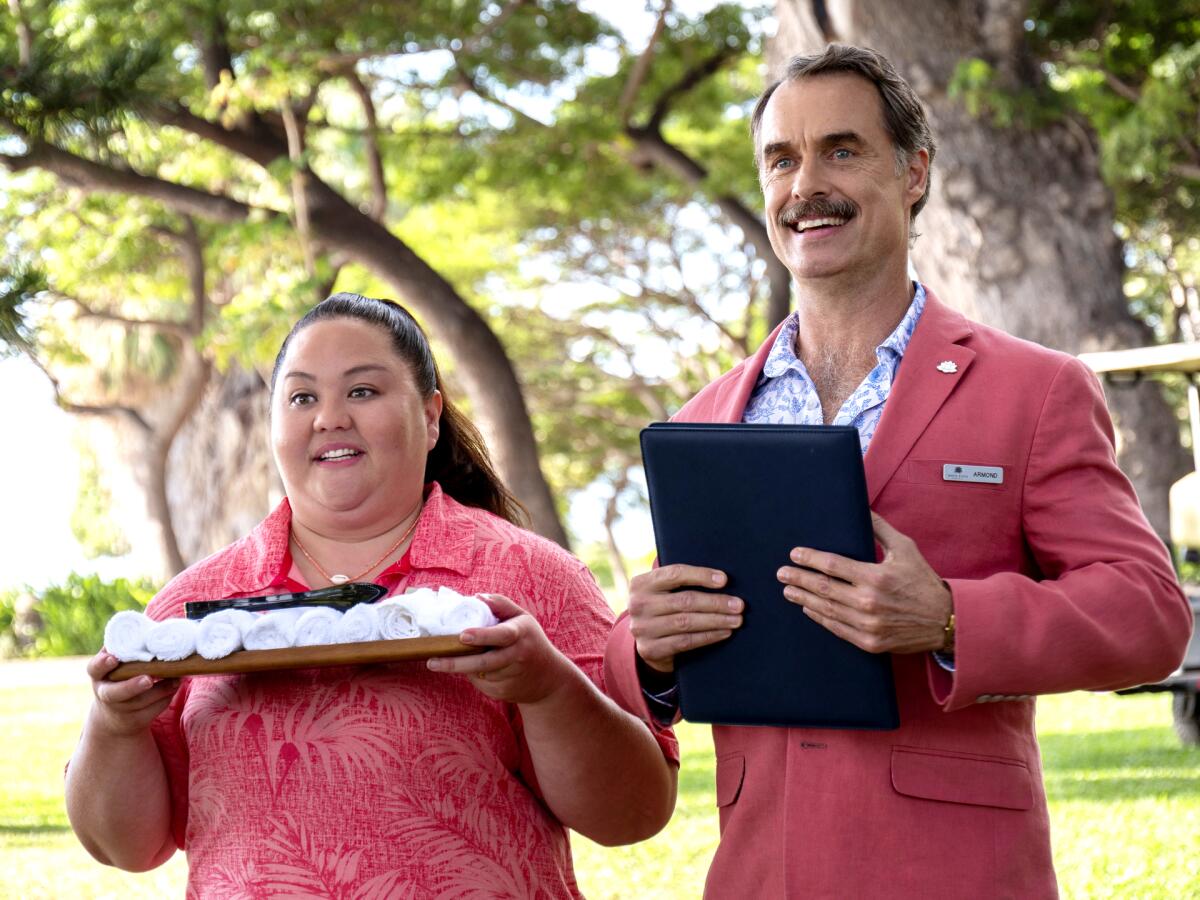
The travel industry contrives all manner of ways to objectify the locals for the benefit of tourists on a quest for the extraordinary or the “authentic.” In Belize, I once wrote about a hotel on a private island where I was greeted on a boat dock by smiling staff members all decked out in matching pith helmets — so colonial! On assignment in Peru, I once visited a high-end textiles boutique geared to tourists whose centerpiece was an Indigenous woman in traditional dress weaving on a strap loom. It felt like the worst sort of 19th century museum display.
A friend who ran a horse packing outfit in Colorado, where he led excursions into the Rocky Mountains, used to get decked out in cowboy duds to provide his clients with postcard color. His normal ensembles of jeans and baseball caps didn’t cut it as “authentic” — even if that’s what he wore when he went riding on his own.
“We see travel as escape, getting away, going somewhere ‘else,’” writes Lippard, “often inhabited by ‘others’ whose dissimilarities will be exaggerated and exoticized.”
HBO canceled ‘Los Espookys’ after two seasons. The uniquely Latino synthesis of deadpan comedy, telenovela tropes and all things Goth was fun while it lasted.
The protagonist in this stage play, of course, is the traveler. “The White Lotus” has its dramas down pat: the spoiled rich kid who threatens to call the manager (Shane in Season 1) or the fussy woman who turns each journey into a happiness quest (Tanya over both seasons).
In my time in the travel mill, I’ve watched an angry American demand a blow dryer at a remote rainforest lodge that didn’t have electricity and a Canadian grow irritated by the meager menu on the floating islands of Lake Titicaca. (It’s not just Americans who are ugly abroad.)
The thing about travel is that many people approach it as something that will offer transformation. As Lippard writes in the opening chapter to her book: “The structure of tourism resembles all ritual behavior — a beginning, a change, and a return to normal.”
That can happen, but it’s not guaranteed. And it depends as much on the open-mindedness of the traveler as on the magic embedded in any given location. One of the unspoken rules of the tourism story — one so perfectly captured by “The White Lotus” — is that you can’t get away from yourself. Wherever you go, there you are.
- Share via
Watch L.A. Times Today at 7 p.m. on Spectrum News 1 on Channel 1 or live stream on the Spectrum News App. Palos Verdes Peninsula and Orange County viewers can watch on Cox Systems on channel 99.
More to Read
The biggest entertainment stories
Get our big stories about Hollywood, film, television, music, arts, culture and more right in your inbox as soon as they publish.
You may occasionally receive promotional content from the Los Angeles Times.
